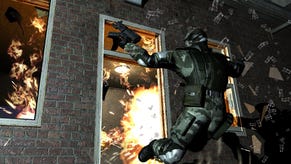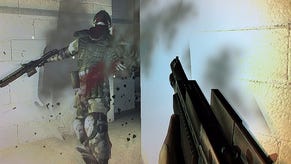The FEAR Effect
Lead designer Craig Hubbard explains his phobophilia.
FEAR's been on our radar for some time now. But then so have lots of things. The difference is, the dot that blinks for FEAR is more like that one off the motion sensor in Aliens. We know that when it eventually rounds the corner, we won't just click mouse1 while backing away perfunctorily; we'll be like suicide-cultists running around a lion's den wearing mangled kittens, screaming, "Kill us! Kill us immediately!" Then we'll get our tools out.
Our interest in FEAR is heightened because, like Lead Designer Craig Hubbard says, the game's about what distinguishes the lobby sequence in The Matrix from '50's cops and robbers shows. "The mechanics are basically identical: guys with guns running around and shooting at each other. What separates one from the other are the particulars of sound, choreography, special effects, editing, etc. Presentation is key."
Excitement's heightened more, too, because it's far from a straightforward shooter. It's about a military base turned over by what appears to be a little girl. Says Hubbard, "A guy in a mask chasing co-eds with a meat cleaver can be scary, but on some level you're thinking to yourself you could probably kick his ass if you got the drop on him." To bring it back to Aliens, that's not what you thought when the dot started blinking. To bring it forward to FEAR, Hubbard is a student of Asian horror, with which it stops being able how on Earth you kill something, but whether on Earth you can. Lots of reasons to be interested, then. With the game just days away, Hubbard talks to us about how it ended up this way.
Well, we didn't set that goal as a marketing hook. Part of it was just to clarify for the team and our publisher that despite the paramilitary themes, we weren't making a tactical combat simulation, which the subject matter tends to imply. We wanted movie reality, not evening news reality. Our primary aim was to make combat as intense as the tea house shootout at the beginning of John Woo's Hard-Boiled. No FPS I've played ever gave me that sensation, so it seemed like a great opportunity.
The bottom line is that people judge your game, not your goals. We figured that if we were successful, the game would speak for itself.
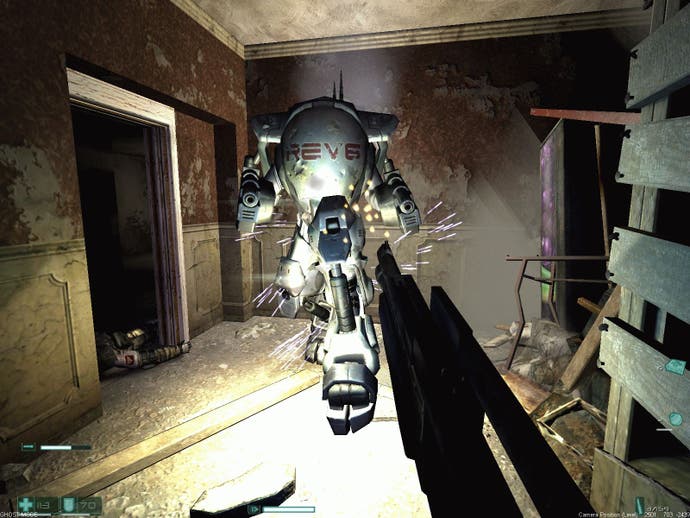
It comes back to trying to make the player feel like an action movie hero. You don't just want to defeat your enemies-you want to do it with style. That might sound like a superficial distinction, but it's crucial. I mean, consider the difference between the lobby sequence in The Matrix and a gunfight in some old '50s cops and robbers show. The mechanics are basically identical: guys with guns running around and shooting at each other. What separates one from the other are the particulars of sound, choreography, special effects, editing, etc. Presentation is key. Slowmo is certainly a big part of that for FEAR, particularly because it has such a significant effect on gameplay.
As for quick-saving, it was never a question. I guess the bottom line is that I can pause a DVD or mark my place in a book, so why shouldn't I be able to save my progress in a narrative video game?
We were really hoping Half-Life 2 would come out when it was originally supposed to, since that would have given us ample time to assess the damage, so to speak, and react accordingly. Luckily, their focus was really different from ours and didn't create a lot of problems. There are definitely similarities because both games are built on some established FPS conventions, but the core experience is pretty dramatically different.
The main impact I personally felt from Half-Life 2 was the time and money they invested in it. It's a monumental accomplishment in terms of scope and polish. Very humbling. But I think combat in FEAR is a lot more fun and visceral, which is another reason I'm glad we weren't focused on physics-oriented gameplay!
As I've mentioned, FEAR is all about close quarters combat, so our chief building blocks were the arsenal, enemies, environments, situations you encounter, and overall pacing of events. We wanted to present new challenges and discoveries throughout the game without arbitrarily changing the rules. For example, we never force you into a mandatory stealth mission or make you fly an airplane. It's more about learning a set of skills and applying them to increasingly complex challenges. We gradually introduce new tools and obstacles, but the goal is to continually riff and expand on a theme rather than to completely change tune every couple of hours.
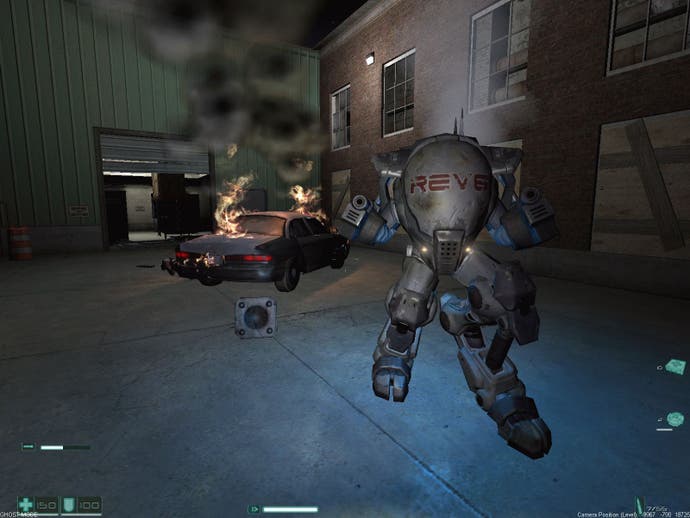
I'm a big fan of ghost stories. I love the skin-crawling sensation I got in The Sixth Sense when the thermostat started dropping or in the original Dark Water when the mother realized the hand holding hers in the elevator wasn't her daughter's. So certainly we hoped to pull off moments like that. But we also included some in-your-face scares to mix things up. The trick is not to become predictable or repetitive.
Horror is hard to gauge because you get numb to it so fast. Whenever I was working on a scary moment, I'd try to get people to play it so I could watch their reactions. Body language tells you a lot. You usually know whether a scene is working before the person even says anything. Of course, different people are scared by different things, so you aren't always going to get the reaction you want. In fact, I actually think comedy is a little easier overall because you can always fall back on pratfalls and fart jokes.
Another issue for us is that because we don't have control over where players move or look, there are no guarantees they'll see what we want them to see. That means you probably won't catch all the scares the first time you play the game.
The way it works for me-and this goes back to No One Lives Forever and Shogo-is that once we determine the subject matter, I immerse myself in it until I develop some fluency. Shogo was already well into development when I came aboard as lead designer. I knew it was supposed to be an anime-inspired action game with giant robots, which is a subject I didn't know much about at the time, so I started watching anime: Patlabor, Ghost in the Shell, Macross Plus, Venus Wars, and so on. After a while, I started to get a sense of the genre's conventions and consistent themes and was able to work some of those ideas into the game, modifying the story that had already been laid out, changing some of the characters, etc. But despite its influences, Shogo was still very much an original game. It isn't an homage.
Same with No One Lives Forever, which evolved into a '60s spy game through discussions with Fox Interactive. I was a big fan of early Bond films, but didn't know a lot about the whole spy craze. So I watched the Derek Flint movies, Modesty Blaise, Matt Helm, Danger: Diabolik, Avengers-anything I could get my hands on. NOLF drew from all those sources, but it's still its own thing. Even though it's very tongue in cheek, it's not a parody like Austin Powers.
FEAR is the first game I've worked on that we based on things I was already passionate about and versed in. I've been a fan of Hong Kong action films for ages. I've loved ghost stories since I was a kid and was already hooked on Asian horror films like Pulse, Memento Mori, and The Eye. I still did a lot of research, of course, but the process was more organic because I was already fluent in the subject matter we were exploring. Like the other games I've worked on, FEAR is more an amalgam of the genres in question than a tribute to a particular film. While we draw from lots of sources of inspiration, we always endeavour to produce something original.
Even in the case of Alma, who has sometimes been compared to Samara in the American adaptation of The Ring (Sadako, in the original film, was a woman, not a child), she was born out of a tradition of eerie, faceless female ghosts and not as an answer to any specific movie character. She admittedly bears some visual resemblance to the ghosts in Dark Water or Séance, but creepy little girls have been freaking me out since The Shining. I think it's because women are harder for a guy to relate to than men and kids are harder to relate to than adults. A guy in a mask chasing co-eds with a meat cleaver can be scary, but on some level you're thinking to yourself you could probably kick his ass if you got the drop on him. But when a spooky little girl takes out an entire Delta Force squad, how are you supposed to deal with that?
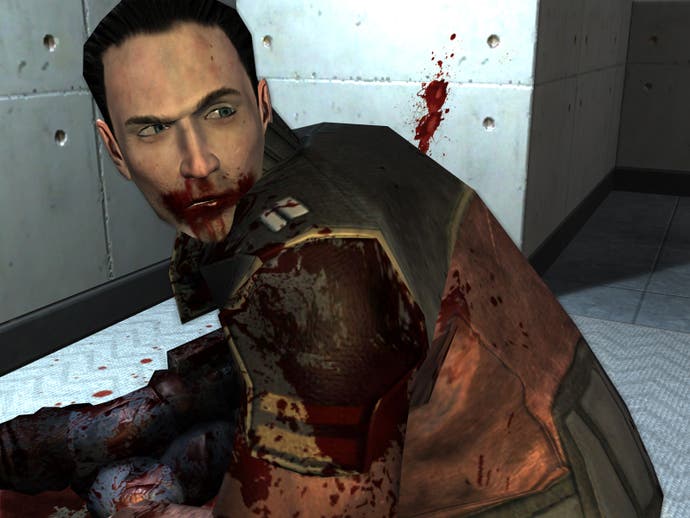
Maybe that's true for some people, but for me quick-saving is automatic. I don't consciously think about it, so it doesn't pull me out of the moment.
The reason it's the "willing suspension of disbelief" is that the audience has to participate in order for the spell to work. There's a difference between looking at the screen and watching the movie. If you get distracted every time you save, you're clearly not very invested to begin with, which may be the fault of the game but probably isn't the fault of the quicksave key.
Either way, I don't think tension should be tied to the fear of losing your progress since the last checkpoint. Frustration and tedium aren't the kinds of emotions we want people to experience when they're playing FEAR.
Not really, but there were some things we cut either because they weren't as fun or cool as we hoped or because we didn't feel we could get the level of polish we wanted in the time we had.
That's actually not really accurate. We came up with a prioritized list of scenes we wanted in the game. Individual designers would mock them up in very rough form so we could get a sense of the gameplay without a big investment of time. We wanted to be able to get quick revisions if things weren't quite there with the first draft.
Once we had a rough playable sketch of the game, we started stringing the scenes together into sequences. This approach gave us a lot of control over pacing.
Content creation is definitely becoming a major challenge. Tools will continue to improve, of course, but it's inevitable that complex content is always going to take longer to create than simple content.
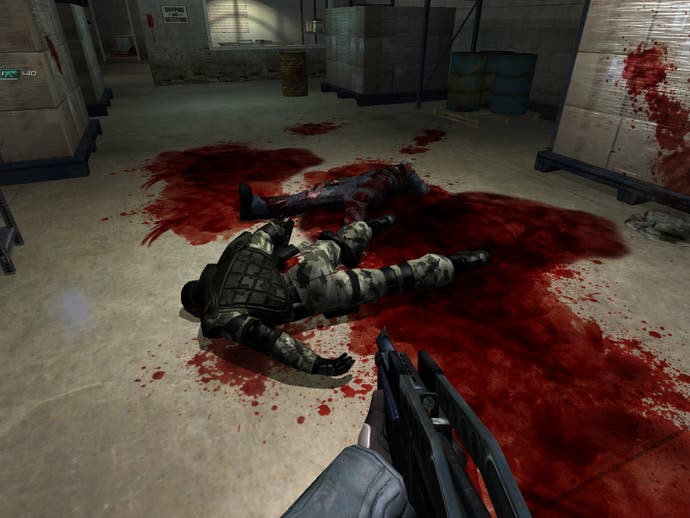
It's basically the same process you use to write a novel, so the real difference is that it's a team instead of an individual. I guess it's just a question of whether you're open to other people's input or feel like you have to generate all the ideas yourself. Every game I've ever worked on has been a collaborative effort. Part of my job is to make sure that the end product has an individual voice, but it's never literally the voice of an individual.
I tried to strike a balance where players would have just enough information to form their own hypotheses about what's going on and why. I didn't want to spell things out too clearly or resolve anything too neatly because that would kill the mood. Horror works best when it leaves you with something to think about or worry about.
The risk, of course, is that we might lose players that aren't paying attention, but I was more interested in the ones that are. I'm not trying to be arty or self-important-I just don't want to spoon feed anybody. The less the audience is asked to think about what's happening, the less participatory the experience becomes.
The biggest challenge was that exposition is significantly harder to manage in-game than in cut-scenes. It's less of a problem in a game like Half-Life 2 where the protagonist isn't supposed to know what's going on and the developer can rely on visual cues to establish the premise. In FEAR, you're part of a special forces team on a mission, so a lot more setup is required to outline the situation. We finally added an opening cinematic because it was the most practical, visually interesting way to communicate key information to the player under the circumstances. When we found some players were still confused about what was going on, we incorporated a briefing that lays it all out matter-of-factly. It isn't the ideal solution, but it gets the job done.
The challenge wasn't really on the engineering side, but on the design side. A lot of people were convinced it would suck to be thrust into slow-mo if you weren't in combat, so there was some opposition before it had even been prototyped. It definitely won't appeal to everyone, but enough of us enjoyed it to justify putting it in the game. As gratifying as it is to take out an AI enemy in slowmo, it's better when it's your friend.
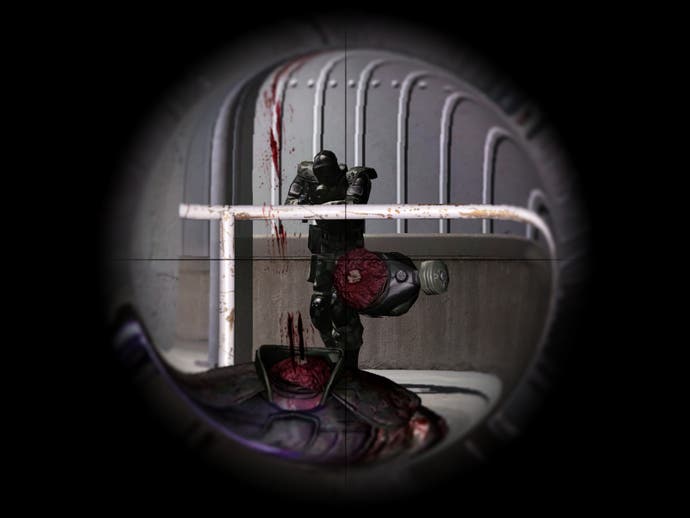
We considered it, but nobody had any ideas that translated into interesting-sounding gameplay. Horror is kind of like humour in that it works best when it's fresh. Seeing the same scary elements over and over in MP would tend to wear down their effectiveness. That's not to say it can't be done, but it wasn't something we latched onto.
Assuming the person liked the premise, I'd tell them to play the demo and see what they think. Games ultimately have to speak for themselves. Nothing I could say would convince somebody to buy the game if they didn't enjoy the demo.
Early on, we talked about wanting a lot of memorable moments in the game, which at that time we were thinking of in terms of scripted blockbuster-style spectacle. We definitely have some of that, but I think what really distinguishes FEAR are the unscripted memorable moments that can occur any time you get into combat. You often feel like a movie hero in a choreographed action scene, except that it isn't choreographed. But it also isn't totally random - it's the interaction of core game systems like AI, physics, weapons, special effects, etc., which means that as you learn the rules of the game, you'll get better at making cool things happen. You'll find yourself timing a shotgun blast so that instead of just taking out an enemy, you get him to fly backward over a cluttered desk and send its contents flying in slowmo. It's a good reminder that even things that don't affect gameplay can still make a game more fun.
FEAR is released on PC worldwide on October 18th.


